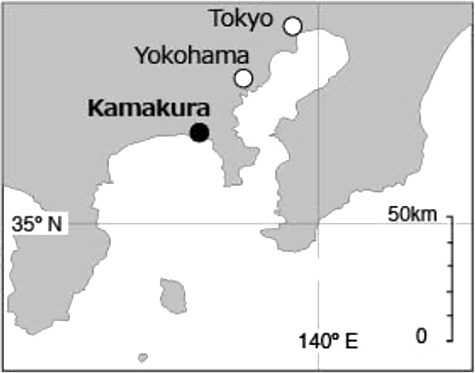August 5, 2018 Near Sakanoshita crossing, at Hase 2 Chome, Kamakura city, Kanagawa Japan, 35°18’N,139°32’E
Moment of findings
1.When and where
2.Species and Size
Blue whale (Balaenoptera musculus) male with total Body Length of 1052 cm
3.How it was found
In the afternoon stranding of a large whale was reported to the Kamakura Police Office. Staffs from the Kamakura City Office and Enoshima Aquarium examined the whale. Howeve, only a preliminary examination could be conducted because of the rough surf. At that time it was identified as a male Sei whale (Balaenoptera borealis) about 10m in total length.
Researchers from the National Museum of Nature and Science (NMNS) saw the video footage of the whale on the TV News and started thinking about the possibility that it was a blue whale. After discussions by telephone between the staffs from the Kamakura City Office, the Enoshima Aquarium, the Kanagawa Prefectural Museum of Natural History (KPMNH) and the NMNS, the NMNS determined it was a blue whale and agreed to investigate it the following day.
4.How it was studied
| Aug. 6 | Photograps and measurements were gathered by the staff members from KPMNH, Enoshima Aquarium, NMNS and local government offices. Because the site is an extremely popular beach resort and local people expected the carcass to be removed quickly, they had to cut the carcass into separate pieces and moved the material by two 5-ton trucks to a working facility. An ad hoc research team was composed of staffs from Enoshima Aquarium, Tsukuba University, Hokkaido University, Utsunomiya University, Nagasaki University, Tokyo University of Marine Science and Technology, Institute of Cetacean Research and NMNH was organised to undertake more detailed studies of the material. |
|---|---|
| Aug. 7 | Various organs were examined and he skeletal elements were collected. |
| Aug. 8 | Further examinations and cleaning were made in Tsukuba Research division of NMNS. |
Photos from the first day Aug. 5.
Four images shown here all taken by Enoshima Aquarium on Aug. 5.

The blue whale when found (around 16:00).
The surface of the skin was full of wrinkles which often found in very young calf of baleen and beaked whales.
The color of the body was bluish gray with faint white marks as if they had been made by a dried brush, which is typical of blue whales. the shape of the flipper was also characteristic of blue whales.
An aquarium staff member examining the right flipper. The leading edge and the inner surface of the flipper are white.
Aug. 6. around 07:00 Started examinations

The whole body viewed from right side. The whale is facing left toward the sea with its belly up.



Extrenal observations, measurements started.
View of the whole body from the posterior end.
Measurements around the genital and anal regions.

Ventral pleats
We counted 61 ventral pleats. Blue whales have between 55 and 88 ventral pleats.


The animal had a penis and therefore a male.
Baleen plates
Black baleen plates indicated that the species is the blue whale.


[Photo left] An example of numerous Conchoderma attachments on one Pennella sp.
[Photo right] The skin was inbedded with Pennella sp. (possiblly P. balaenoptera) (yellow arrow), and it was attached by another parasite Conchoderma virgatum (green arrow), a barnacle attached to the Pennella.
Dorsal fin
Extremely small dorsal fin compared to the body size is another character which also indicates its blue whale. Animal was resting with his belly up and the dorsal fin was seen up side down. The round hole at the base is a healed bite from a cookie-cutter shark (which has nothing to do with the cause of death.).
An ad-hoc research team was organized led by the National Museum of Nature and Science. They started the preparation of the carcass so that it could be transported to proper working facility.
The research team consisted of staff members from the following institutions: the Enoshima Aquarium, Tsukuba University, Hokkaido University, Utsunomiya University, Nagasaki Uniersity, Tokyo University of Marine Science and Technology, Institute of Cetacean Research and National Museum of Nature and Science.
Aug. 7 Processing and examination of the organs and collection of skeletal elements were conducted.


The rows of baleen plates each side of the mouth:
Note the pitch black baleen plates and bristles, found only in blue whales.
Analyses on the baleen plate might reveal something about its movements.
Left and right pelvic bones:
Which were completely cartilaginous.

Contact
Yuko Tajima (Department of Zoology, Division of Vertebrates)
E-mail: yuko-t@kahaku.go.jp